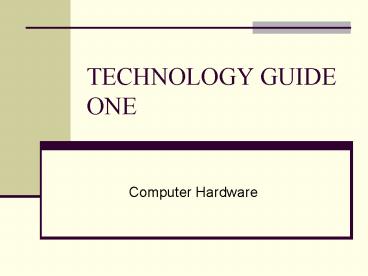TECHNOLOGY GUIDE ONE - PowerPoint PPT Presentation
1 / 39
Title:
TECHNOLOGY GUIDE ONE
Description:
Hardware refers to the physical equipment used for the ... Magnetic tape reel. Magnetic tape cartridge. Hard Drive (Magnetic Disks) Optical Storage Devices ... – PowerPoint PPT presentation
Number of Views:68
Avg rating:3.0/5.0
Title: TECHNOLOGY GUIDE ONE
1
TECHNOLOGY GUIDE ONE
- Computer Hardware
2
TG1.1 Introduction
- Hardware refers to the physical equipment used
for the input, processing, output and storage
activities of a computer system.
3
Hardware consists of
- Central processing unit (CPU)
- Primary storage
- Secondary storage
- Input technologies
- Output technologies
- Communication technologies
4
TG1.2 The Central Processing Unit
- Central processing unit (CPU) performs the actual
computation or number crunching inside any
computer. - Microprocessor
- Control unit
- Arithmetic-logic unit (ALU)
- Registers
5
Central Processing Unit (CPU) (continued)
6
How the CPU Works (continued)
See this view from Intel of how a chip works
7
Advances in Microprocessor Design
- Moores Law microprocessor complexity would
double every two years.
8
The Evolution of Chips
- For a look at the evolution of chips from the
Intel 4004 to multicore chips, click here.
9
Evolution of Computer Power/Cost
10
TG1.3 Computer Memory
- Two basic categories of computer memory
- Primary Storage
- Secondary Storage
11
Memory Capacity
- Bit
- Byte
In this picture, one byte, 01001000, represents
the letter H
12
Hierarchy of Memory Capacity
- Kilobyte
- Megabyte
- Gigabyte
- Terabyte
- Petabyte
- Exabyte
- Zettabyte
13
Primary Storage
- Primary storage or main memory stores three types
of information for very brief periods of time - Data to be processed by the CPU
- Instructions for the CPU as to how to process the
data - Operating system programs that manage various
aspects of the computers operation. - Primary storage takes place in chips mounted on
the computers main circuit board, called the
motherboard.
14
Main Types of Primary Storage
- Registers
- Random access memory (RAM)
- Cache memory
- Read-only memory (ROM)
15
Internal workings of personal computer
Hard disk drive
CPU board with fan
RAM
Floppy disk drive
16
Primary versus Secondary Memory
17
Secondary Storage
- Memory capacity that can store very large
amounts of data for extended periods of time. - Magnetic tape (sequential access)
- Magnetic disks (direct access)
18
Magnetic Tape
Magnetic tape reel
Magnetic tape cartridge
19
Hard Drive (Magnetic Disks)
20
Optical Storage Devices
- Optical storage devices A form of secondary
storage in which a laser reads the surface of a
reflective plastic platter. - Compact Disk, Read-Only Memory (CD-ROM)
- Digital Video Disk (DVD)
21
Flash Memory Devices
22
Thumb Drive
23
Enterprise Storage Systems
- Enterprise storage system An independent,
external system with intelligence that includes
two or more storage devices. - Three types of enterprise storage
- Redundant Arrays of Independent Disks (RAID)
- Storage Area Network (SAN)
- Network Attached Storage (NAS)
24
Evolution of Man and Storage
25
TG1.4 Computer Hierarchy
- Supercomputers
- Mainframe Computers
- Midrange Computers
- Workstations
- Notebooks and Desktop Computers
- Ultra-mobile PCs
- Computing devices
26
NASA Supercomputer
27
Mainframes and Mid-range computers
IBM iSeries midrange computer
IBM System Z mainframe
28
TG1.5 Input and Output Technologies
- Input technologies allow people and other
technologies to put data into a computer. The two
main types of input devices are - human data-entry devices include keyboards,
mouse, trackball, joystick, touchscreen, stylus
and voice recognition - source-data automation devices input data with
minimal human intervention (e.g. barcode reader).
- Speed up data collection
- Reduce errors
- Gather data at the source of a transaction or
other event.
29
Input and Output Technologies (continued)
- Output generated by a computer can be transmitted
to the user over several output devices and
media, which include - Monitors
- Printers
- Plotters
- Voice
30
Weve come a long way!
Keypunch machine
Punch card
31
The First Mouse
A very early (if not the first) mouse
demonstration in 1968.
32
Microsoft Seadragon
- Microsoft Seadragon is a very interesting
interface. See a demonstration here.
33
The Multitouch Screen
Jeff Han presents the multitouch screen at the
TED talks.
34
Microsoft Surface Computing
Microsoft Surface Computing offers a new
interface for users. This technology is also
called the Microsoft coffee table. Demo
Another look at Microsoft Surface Computing
Demo
35
Bluetooth Laser Virtual Keyboard
36
The Maltron Keyboard
37
Multimedia Authoring System
38
TG1.6 Innovations in Hardware Utilization
- Server Farms
- Virtualization
- Grid computing
- Utility computing
- Edge Computing
- Autonomic Computing
- Nanotechnology (see these slides)
39
TG1.7 Strategic Hardware Issues
- How do organizations keep up with the rapid price
and performance advancements in hardware? - How often should an organization upgrade its
computers and storage systems? - Will upgrades increase personal and
organizational productivity? - How can organizations measure such increase?
- How do organizations manage telecommuting?































